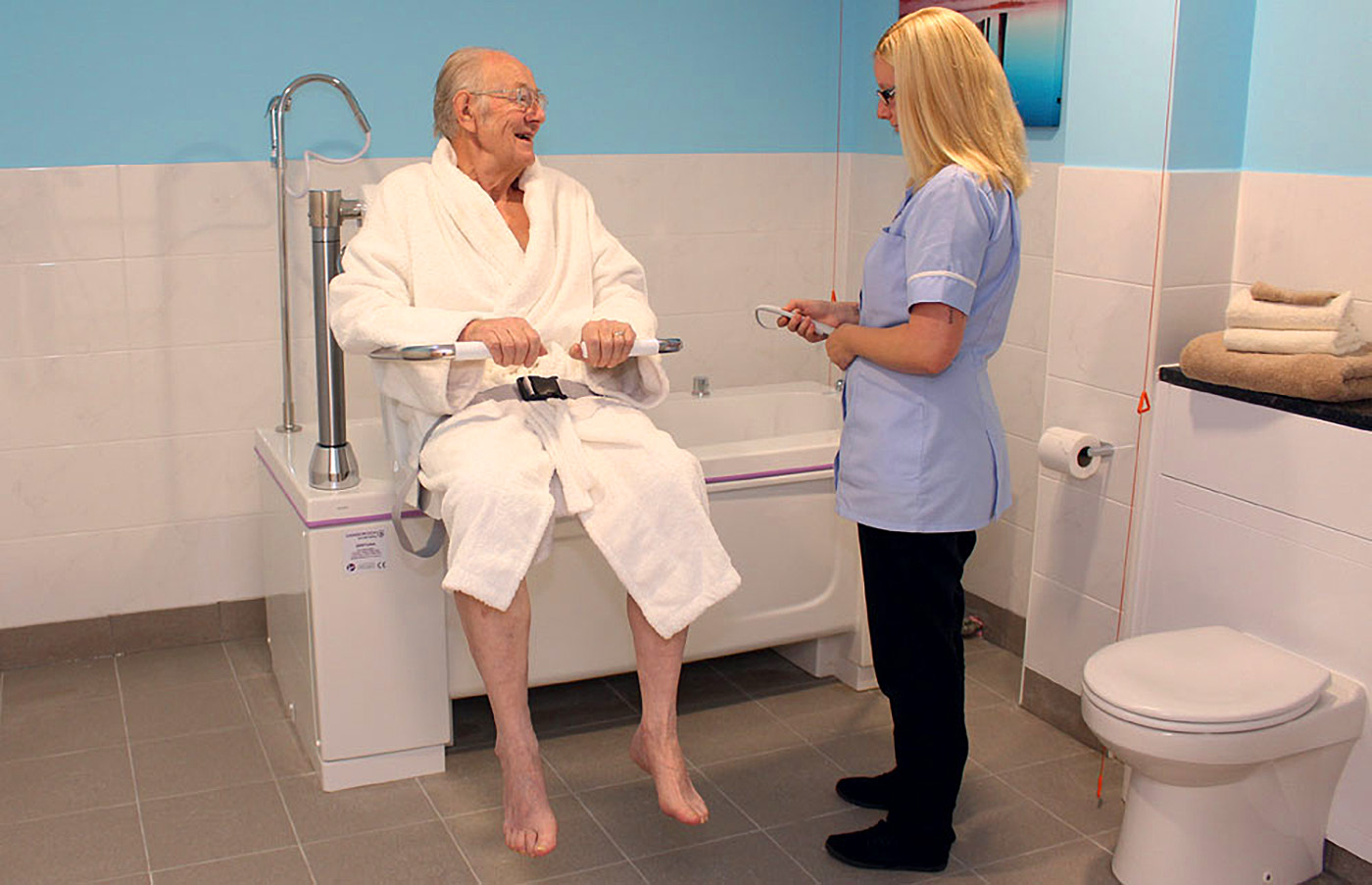Benefits of bathing to clients and carers
An outline to the clinical and practical advantages of specifying specialist assisted baths vs. adapted showering.
)
Provision of specialist power-assisted baths provides many benefits in the long term care sector. In most care homes, communal bathroom facilities provide an essential option to complement ensuite wet rooms and adapted showering facilities. In terms of client care, operational efficiency and carer protection, baths with specialist ergonomic features deliver a critical solution in today’s high demand care environment. Several considerations that highlight this fact are outlined below.
Operational benefits of efficient assisted baths
Specialist baths, from leading manufacturers, with features such as powered variable height and bather transfer seats, will provide an efficient bathing solution for a variety of care scenarios. They facilitate assisted transfers for disabled bathers so the experience is safe, dignified and reassuring. Equally carers can implement moving and handling best practice so the risk of injury is negated during the transfer process. Operational performance in the bathroom can be greatly improved with an appropriate assisted bath that has been specified for certain resident needs. Transfers can be less complex, risk of falls is reduced and the overall experience for clients is more pleasant in comparison to being showered by a carer on a stool or chair.
In addition, the benefits of bathing for residents can offer advantages outside of the bathroom. Many factors associated with bathing such as improved mobility and reduced pain can result in the need for less carer support which eases pressures on staff resources. In summary and in comparison to wet rooms, the right assisted baths can deliver:
- Improved experience for bathers in terms of dignity, comfort and support
- Increased well-being of residents which can improve behaviour and mobility
- Safer bathing cycles with efficient moving and handling for carers
- Lower risk of downtime with less chance of leaks and drainage issues
- More efficient infection control with a lower risk of infectious outbreaks
- Reduced risk of staff sickness through musculoskeletal injuries
Cost savings associated with assisted baths
All healthcare providers understand they have a duty of care to ensure optimal support and dignity for clients. This commitment is delivered through the help of appropriate assistive equipment such as accessible baths and wet rooms. However providing solutions that deliver utmost care yet maximise budgets is a challenge.
This is where ultra-efficient assisted baths provide tangible savings. Baths with cutting-edge technology, such as the range from Gainsborough, can provide cost savings in terms of reduced water and energy use. Coupled with efficient installation, reliable performance and competitive pricing, the selection of certain baths can represent a more cost effective choice in certain scenarios. When compared to wet rooms, specialist baths can ease budget pressures through:
- Reduced lifetime maintenance and servicing costs
- Long term value
- Lower water and utility bills through cost saving design features
- Faster, less complex design, planning and installation
- Lower staffing costs as residents may require less intervention due to the well-being benefits of bathing
Enhanced moving and handling for carers and bathers
Most UK adults living with a disability seem to prefer bathing to showering. However, commonly new care home residents have not been able to access a bath for extended periods. This is due to reduced mobility and subsequent difficulties getting in and our of the bath safely and with confidence. This risk of falls and injury can compromise the experience resulting in showering or other means of washing. Being given the opportunity to bathe safely in a care facility is greatly welcomed by many residents.
Equally carers and relatives in the community are at risk of musculoskeletal injury, particularly back issues, when manually assisting disabled bathers.
Without appropriate assistive equipment the bathing experience can be negative and challenging. This can lead to baths not being used and showering chosen as a safer alternative. Not as pleasant or dignified especially if personal care has to be administered, showering also can present more complex transfers or safety risks when compared to a bath. In a care home environment the need for safe bathroom processes is even more essential. This is where an appropriate powered bath can reduce many potential risks associated with showering as greater support is given to residents and carers having more control. Bath benefits include:
- Lower risk of bather injury from falls or slippages
- Reduced risk of carer injury and subsequent sick leave
- More effective and simplistic transfers with an ability for faster carer response
- Resident positivity and dignity is increased with reduced manual handling
- Greater engagement between carer and client Carers remain dry during bath time hence safety is improved
Care benefits of bathing
Bathing can have a positive effect on resident mobility, mood and well-being. Having access to a specialist bath in a care home does not only
provide safe bathing, the act of bathing itself can improve many day-to-day activities outside of the bathroom. From a legislative point of view, provision of a bath conforms to a specific Human Rights Act which is a critical consideration. By promoting improved Occupational Performance through bathing, carers are helping to achieve a positive outcome. Pain and discomfort can also be reduced through:
- Enjoying a warm, relaxing experience
- Avoiding the ‘car wash’ experience of being sprayed on a transit chair or shower stool
- Inducing sleep
- In-built antimicrobial technology which can deliver protection against bacteria
- Improving bather dignity
- Reducing muscle/joint stiffness
- Reducing stress associated with manual moving and handling
- Helping with the use of prescribed ointments
- Promoting stimulus through options such as chromotherapy lighting, hydrotherapy AirSpa and Bluetooth music
![Gainsborough Specialist Bathrooms [logo]](https://www.gainsboroughbaths.com/wp-content/themes/gainsborough-theme/assets/img/gsb-logo-white.svg)
